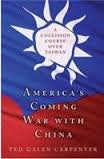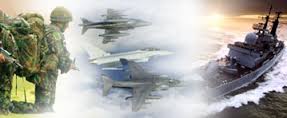Americas coming War with China (2005) by Ted Galen Carpenter. Palgrave Publishing
This summary is intended for those looking at International Security, China, US foreign policy and history. Carpenter begins with a future imaginary war between the US and China over Taiwan. The picture he paints is vivid and seemingly generated by a love of narrative and fiction. It is not until the subsequent chapters and Carpenters conclusion that we see that the imaginary war is in fact a result of his research and is more of a prophesy.
The future war begins with Taiwan’s independence rhetoric delivered through its media and the call by the president to change the state’s official name from Republic of China. The PRC then ramp up the action to reclaim Taiwan and cause the US to send aircraft carriers into the strait between the two states. China begins to take offence and after years of developing its own military to deal with the issue of Taiwan bombs the US naval presence. After airstrikes by USAF on the Chinese mainland the issue of Nuclear weapons raises its head and the war calms down to the point where Taiwan become part of China again, the US is humiliated militarily and economically after Chinese shedding of US bonds. Pages 1-25
At this point it may be right to scoff but after careful reading of the ensuing chapters Carpenter presents a good case for this being a decent stab at what might happen. Carpenter begins by laying the blame in the hands of the Chinese and colonial expansion in general. In 1895 A war between China and Japan over Korea resulted in Taiwan been given to Japan after Chinese defeat. Taiwan (already showing an independent streak) declared independence and made it a Japanese police state. Despite the occupation or may be because of it Taiwan developed a new culture and became a very different place to mainland China in 1943.
This became todays problem when Churchill and Roosevelt divvied up ex Japanese land and gave Taiwan to the Chinese after a Cairo conference. Here lyeth the problem. The US created their own problem. The ‘rough landing’ Page 34 China made on Taiwan upset locals and felt the hard work of developing a strong economy and industry was undone. Further local upset was caused by the nationalists using Taiwan as a base during the war with Mao in 1949.
Previous to the Cairo treaty Churchill and the US president decides on Mao had stated that he did not consider Taiwan ‘lost territory’ Page 37 But the two western leaders legitimised Chinese sovereignty over Taiwan in Cairo. This confuses things today.
During the Korean War in the 50’s Truman sent Aircraft carriers to the area and there was thinking that the US should use Nuclear weapons on mainland China to make the nationalists on Taiwan more able to reclaim what the communists had taken. In fact Eisenhower asked why ‘’Nuclear weapons shouldn’t be used exactly as you would a bullet’’ Page 43
In the 60’s JFK changed stance to recognise PRC as official China. This was however just a way of stoking up Chinese anti USSR feelings. This was clever by the US and Kissinger as the US strategy was to use Chinese war theorist Sun Tze’s philosophy and engage in war by causing friction with your enemies alliances.
In 1979 the US agreed to sell arms to Taiwan and including high tech fighter aircraft in 1981. Concomitantly, Chinese-US relations also improved due to Deng Xiapings modernisation and the need for China to import to develop.
Taiwan replied by democratising the country in order to win over US congressional support. Whatever the impact Bush Snr sold 150 top of the range jets to Taiwan in 1992. This could have been due to the fact Bush Snr was fighting an election and need the votes a big defence contract would bring. (he lost anyway) This gave Taiwan the confidence to court relationships with other nations which incensed China. 150,000 troops moved to Fujian province just over the water and after renewed US naval presence a further arms deal was signed including Attack Submarines. Page 71
Today the US want to trade with China and support democracy in Taiwan. A tricky situation. Any strategic ambiguity was cleared up by Bush Jrn in 2001 when he said ‘’we will defend Taiwan’’ Page 127.
All changed after 9/11 when China was needed by the US to reign in North Korea and assist with pressuring Pakistan and Central Asia to cooperate with dealing with terrorism.
In 2004 however the rise of China turned the tables. China now had the ability to take Taiwan. Reports and Think Tanks saw that 700+ Ballistic missiles were trained on Taiwanese economic hubs. The issue remained that Taiwan had decent air defence and only 20% of shoreline useful for amphibious assault. Page 153
The tipping point would be the introduction of a blockade that would result in Chinese submarine being hunted by depth charges. This would lead to an open naval warfare that would see China now superior Navy win out.
All this may seem as hypothetical as the initial chapter but is borne out by reliable intelligence and research. This was all thought through in 2005 and then said it would take 10 years for China to develop the amphibious hardware to invade or more of the same naval power to win any naval warfare brought about by a blockade.
The book, although depressing does show the kind of way China has been strategically moving to ensure a successful war over Taiwan and warns the west over interfering in sovereignty issues. It encourages us to find a peaceful end to the ‘one china’ dispute and perhaps the west should explain to Taiwan it would need to defend itself in the future and stay out of this affair. It seems inevitable that Taiwan will return to mainland control and other states in the area should not antagonise China into a war it cannot win (I.e Japan and the Diayou Islands)


